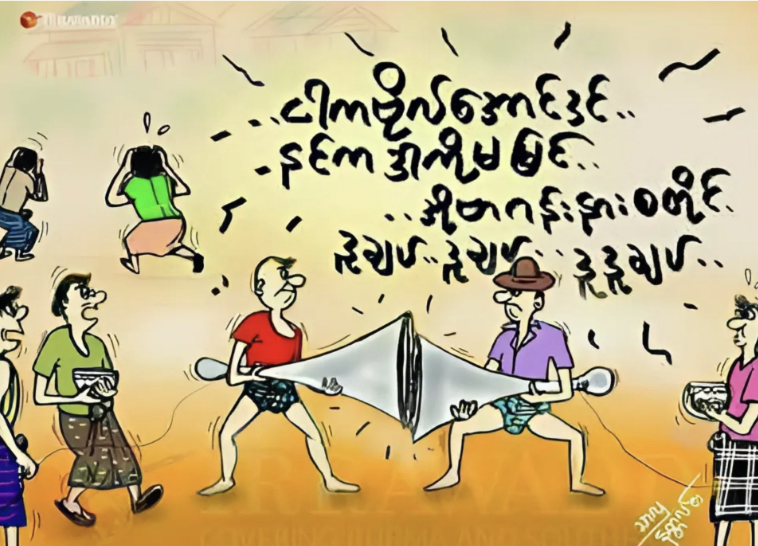A Noise Contest
In this cartoon, a Burmese artist captures a scene that many in Myanmar will find all too familiar. The drawing shows two men standing opposite each other, each wielding a large loudspeaker, with blaring music represented by chaotic lines that fill the air. Meanwhile, nearby onlookers appear visibly distressed—one covers her ears, while others look on in frustration. The Burmese text above reads, "They're playing famous songs to see who can be the loudest," succinctly summarizing the absurd competition taking place.
The artist’s message is clear—this is a humorous but sharp critique of the loudspeaker battles that have become a common nuisance in Burmese society. These battles, which often take place during weddings, religious festivals, or other communal events, are emblematic of a larger cultural trend: the use of loud music as a way to assert one's presence or importance. The intent behind these displays may be to celebrate or draw attention to an occasion, but to those not involved, it often feels like an imposition—a form of noise pollution that they have no choice but to endure.
The use of loudspeakers in Myanmar is deeply woven into the fabric of daily life. From religious ceremonies to political rallies to the Thingyan Water Festival, amplifying sound is a way to gather attention and convey significance. In urban centers like Yangon, where the sounds of traffic and construction are already overwhelming, the addition of competing loudspeaker battles only adds to the chaos. It's not uncommon for people to endure sleepless nights or find themselves unable to concentrate as the noise spills into all aspects of life.
In this context, the cartoonist's illustration is a plea for change. It points out, in a light-hearted yet impactful manner, that the constant competition over who can be louder is far from harmless—it is damaging to the community. The two men competing with their loudspeakers are portrayed as being oblivious to the discomfort they cause. Their focus is entirely on outdoing each other, without a thought for the people around them. The discomfort of the figures in the background—one of whom is covering her ears, visibly distressed—is a powerful reminder of how such behavior impacts others.
The artist's message here suggests that culture and tradition can still be respected, but in ways that are considerate of the comfort and well-being of everyone in the community—not just those holding the loudspeaker. By highlighting this issue, the cartoon invites viewers to think critically about the way sound is used in public life and whether there might be a better, more harmonious way forward.

